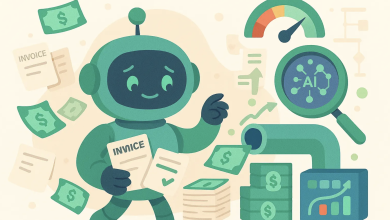Financial reporting plays a critical role in a company’s accurate performance tracking and informed operational and strategic decision-making. However, producing timely and accurate reports compliant with all the relevant regulations is becoming challenging for many organizations due to dramatic data volume growth and ever-changing regulations and reporting standards.
To overcome these complications and future-proof their financial workflows, companies across industries are increasingly turning to AI-enabled financial reporting tools. Those leading the way are already seeing clear benefits, such as reduced manual work and improved accuracy of financial analysis and forecasting.
In this article, we explore the ways that integrating financial statement reporting software with AI tools can improve the operations’ speed, accuracy, and compliance, as well as key preparation measures to ensure successful implementation of AI into financial reporting.
4 ways AI is transforming financial reporting
From automating manual work to uncovering insights faster, here are the most impactful applications of AI for financial reporting.
Data standardization & validation
Financial report creation begins with the consolidation of various financial data from multiple sources like corporate systems, spreadsheets, emails and documents, and external financial data providers. Equipped with dedicated AI tools, financial reporting software can accelerate the standardization of data presented in disparate formats, as well as the extraction of data from PDFs and other documents, making the information ready for processing by financial teams in near real-time.
Furthermore, AI tools can be used to validate the collected financial data for accuracy, conducting rule-based checks against corporate policies and accounting guidelines, comparing it with data from other systems to detect mismatches, or even flagging unusual patterns and inconsistencies that can indicate suspicious activities. By automating data validation, AI ultimately improves financial reports’ accuracy and speeds up their creation.
Report generation
Instead of spending hours compiling detailed and accurate reports, financial teams can delegate this task to AI now. Integrated into financial reporting software, generative AI tools can use pre-defined templates to create various types of financial reports, from simple balance sheets to department or segment-specific breakdowns, tailoring their content or presentation if necessary to better meet target audience’s preferences. Such tools will distill large and complex datasets into coherent reports and update them in near real-time as new data comes in, providing them to financial teams for review and presentation.
Additionally, AI tools can provide contextual commentary, highlighting key trends or anomalies uncovered by financial reports, or even generate plain text narratives to explain major business context changes. This way, AI increases financial reports’ clarity and helps stakeholders quickly grasp the story behind the numbers.
Regulatory compliance reporting
Organizations operating in complex and highly regulated financial environments can struggle with keeping their reports aligned with all the relevant regulations. To mitigate the risk of human error and prevent potential fines, financial teams can appoint AI to keep their reports accurate, compliant, and auditable.
AI can be applied in several ways to streamline regulatory compliance reporting. First, AI tools can tirelessly monitor regulatory websites and news sources for policy changes or updates and automatically identify whether they apply to the company and how. If necessary, such solutions can suggest changes to reporting workflows and templates, as well as financial data management policies on the whole, to reflect updated regulatory requirements.
Further on, when generating financial reports, generative AI tools embedded into the reporting software can automatically follow all the applicable regulatory and accounting rules to make the report compliant with legal and compliance standards from the get-go.
Valuable insights generation
AI can help companies move beyond traditional static financial reports to more dynamic and engaging ones without dedicating extra human resources and efforts to it. Implemented into financial reporting software, machine learning algorithms can detect hidden patterns in historical financial data, run multiple “what-if” scenarios, and highlight future risks for the company.
As a result, executives, investors, regulators, and teams get accurate financial reports that provide context for historical numbers, forecast future performance, and highlight risks but nevertheless stay compliant to the established format and regulatory requirements.
How to get started with AI-enabled financial reporting
Companies need to take the following steps to properly prepare for adoption of AI-powered financial reporting tools so that this transformation would deliver the expected results and return on investment.
- Assess current data management processes: The financial data needs to be accurate, reliable, and structured for an AI tool to function properly. Thus, businesses need to review their existing financial data management workflows and storage solutions and detect and fix any issues or gaps that can lead to data corruption or inconsistency.
- Select suitable AI tools: Opt for AI-based financial software with functionality that covers your selected use cases, complies with data management and security regulations specific to your industry, and offers robust APIs for integration with the company’s financial systems for more efficient data flows.
- Start with a pilot project: Instead of implementing a full-scale AI-enabled reporting solution, start with a PoC solution that focuses on automating a single workflow, such as checking data accuracy or handling compliance reports. This allows a financial team to get comfortable with the technology, while stakeholders can monitor the PoC’s implementation results and tailor the solution accordingly.
- Upskill the financial team: To make sure finance specialists know how to work with AI-powered financial software and interpret the reports and insights it delivers, companies need to invest in additional employee training learning and conduct internal workshops equip teams with practical skills.
Conclusion
AI is expected to transform financial reporting operations, already bringing the speed, accuracy, and efficiency into the generation and management of reports that allows companies to make better business decisions faster and gain competitive advantage. However, to unlock the full value of AI-powered financial reporting tools, organizations need to take several preparatory steps and align certain workflows to support the proper AI model operation. But when done properly and thoughtfully, the implementation of AI-powered financial software can enable faster delivery of more accurate financial insights.





